Taos Pueblo 4-piece Nacimiento by Alma Concha - C3438D
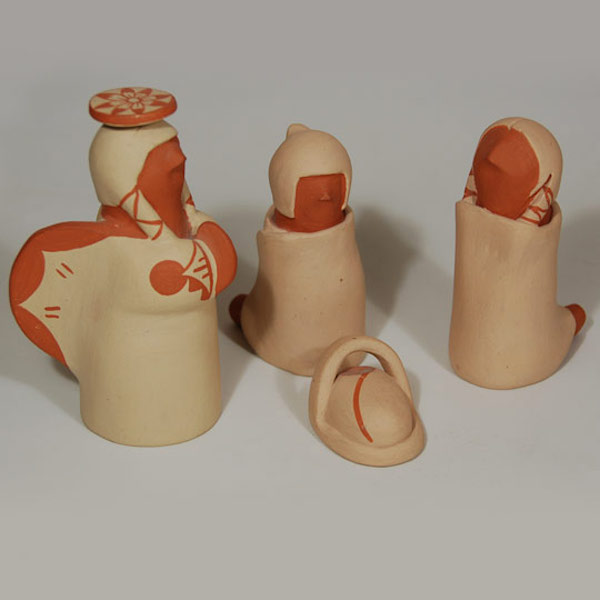 Although Alma Concha is from Jemez/Laguna Pueblos, she is mostly known for the figures she made during her years at Taos Pueblo. She learned to make pottery from her mother Carrie Loretto of Jemez Pueblo and has gone on to produce some of the most collectible nacimientos. Her figures have little or no painted designs and are typically wrapped in undecorated blankets. Usually the human figures have prominent noses and no eyes but the animals have painted eyes. Alma has been known to make the male figures with the Pueblo chongo but since living at Taos, she has created the figures with Taos braids. Alma makes nacimientos with large figures and miniatures and uses a slip of red and buff.
Although Alma Concha is from Jemez/Laguna Pueblos, she is mostly known for the figures she made during her years at Taos Pueblo. She learned to make pottery from her mother Carrie Loretto of Jemez Pueblo and has gone on to produce some of the most collectible nacimientos. Her figures have little or no painted designs and are typically wrapped in undecorated blankets. Usually the human figures have prominent noses and no eyes but the animals have painted eyes. Alma has been known to make the male figures with the Pueblo chongo but since living at Taos, she has created the figures with Taos braids. Alma makes nacimientos with large figures and miniatures and uses a slip of red and buff.
Ten-Piece Pottery Multi-Color Nacimiento by Stella Teller - C3842
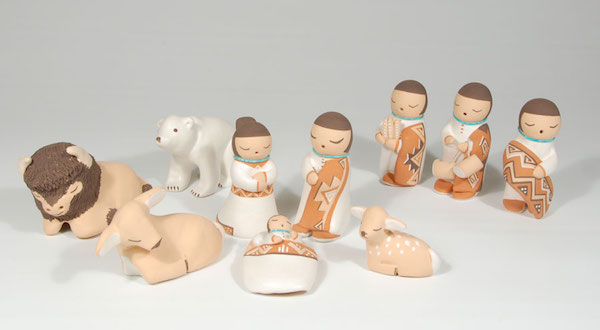 Stella Teller began making pottery in the early 1960s and is well known for her use of the color grey and adding turquoise hieshe necklaces to the figures whether it be human or animal. Stella also polishes the white slip on her animal figures. Several members of her family make nacimientos but none are as collectable as those made by Stella which can command high prices. Stella also makes sets in polychrome, the colors being beige, yellow, brown and white.
Stella Teller began making pottery in the early 1960s and is well known for her use of the color grey and adding turquoise hieshe necklaces to the figures whether it be human or animal. Stella also polishes the white slip on her animal figures. Several members of her family make nacimientos but none are as collectable as those made by Stella which can command high prices. Stella also makes sets in polychrome, the colors being beige, yellow, brown and white.
Tesuque Pueblo 19-piece Nacimiento Set by Manuel Vigil - C3590C
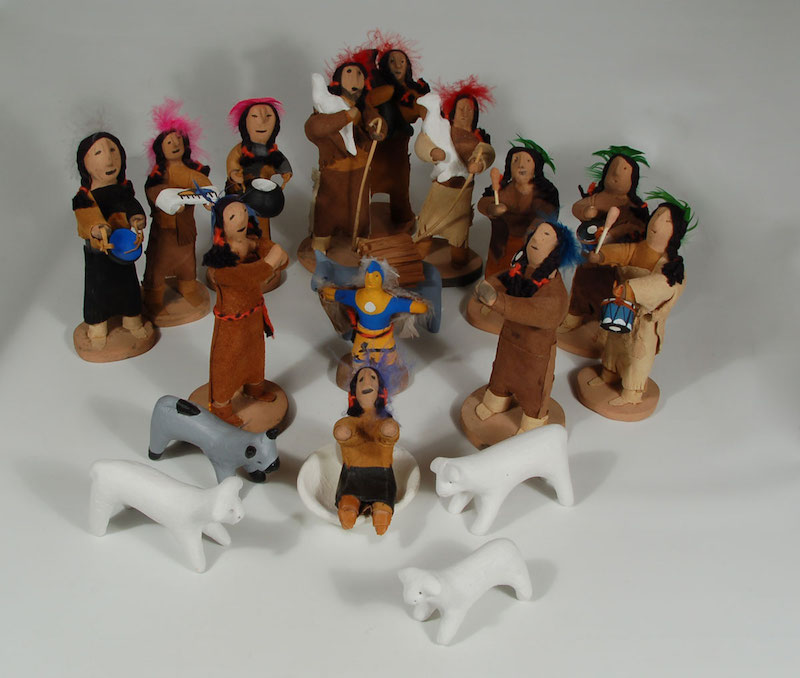 Manuel Vigil is probably the best-known potter of the 20th century from Tesuque Pueblo. He learned to make pottery by the age of seven by watching his mother make pottery. He specialized throughout his career in making figurine pieces. He is credited with being the first Native Puebloan to make Nacimientos (Nativity sets). Pueblo dance figures were a favorite of his. Later, he made storyteller figurines.
Manuel Vigil is probably the best-known potter of the 20th century from Tesuque Pueblo. He learned to make pottery by the age of seven by watching his mother make pottery. He specialized throughout his career in making figurine pieces. He is credited with being the first Native Puebloan to make Nacimientos (Nativity sets). Pueblo dance figures were a favorite of his. Later, he made storyteller figurines.
Hopi Pueblo Contemporary Pottery Pictorial Tile by Gwen Setalla - C3843M
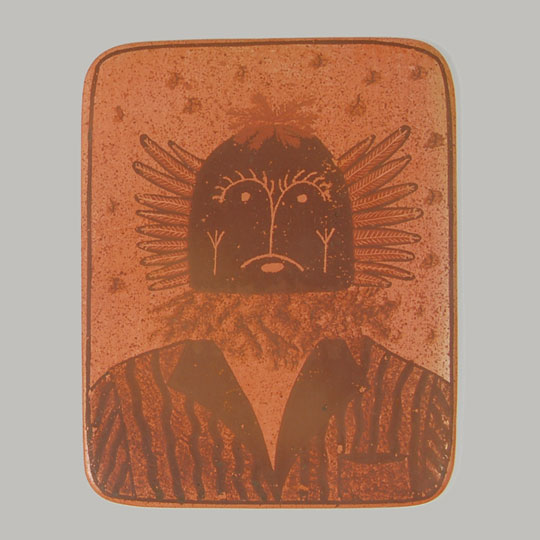 Gwen Sharon Setalla (b.1964-) Aȁs-kữ-Mana is a Hopi from the village of Mishongnovi on Second Mesa. Her mother is Pauline Setalla from Mishongnovi. They are of the Frog Woman and Feather Woman families. The family lived on a ranch not far from Keams Canyon and Gwen spent her early childhood there. She learned pottery making from her mother, starting as early as age 5 and began to take it seriously by age 21.
Gwen Sharon Setalla (b.1964-) Aȁs-kữ-Mana is a Hopi from the village of Mishongnovi on Second Mesa. Her mother is Pauline Setalla from Mishongnovi. They are of the Frog Woman and Feather Woman families. The family lived on a ranch not far from Keams Canyon and Gwen spent her early childhood there. She learned pottery making from her mother, starting as early as age 5 and began to take it seriously by age 21.
Original Painting “Eagle Dancers and Drummer” by Bronson Edwards - C3839H
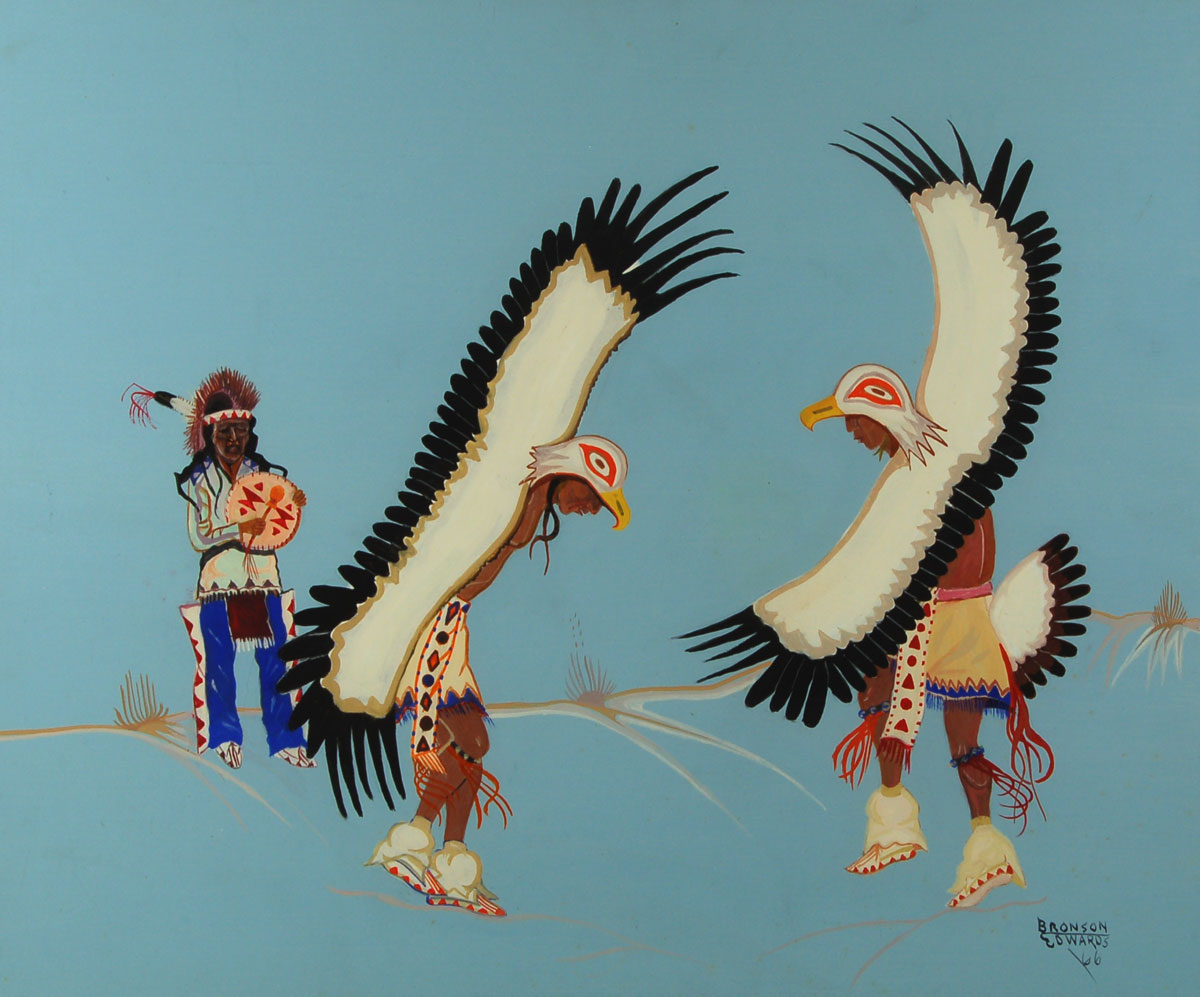 Bronson Wilbur Edwards came from a family of important Ottawa Indians. His maternal grandfather was Mon Ton Kee, an Ottawa Chief (1880-1888). His great grandfather was Ottawa Chief, John W. Early, Wask Kos.
Bronson Wilbur Edwards came from a family of important Ottawa Indians. His maternal grandfather was Mon Ton Kee, an Ottawa Chief (1880-1888). His great grandfather was Ottawa Chief, John W. Early, Wask Kos.
Bronson Edwards lived in Miami, Oklahoma. He had attended High School there and then took correspondence courses in art. His career included sign painter, commercial artist, free-lance artist, and painter. He apparently did not begin to paint seriously until 1947, so he only had a 25-year art career.
Santa Clara Pueblo Stone Polished Black Jar by Sara Fina Tafoya - 25716
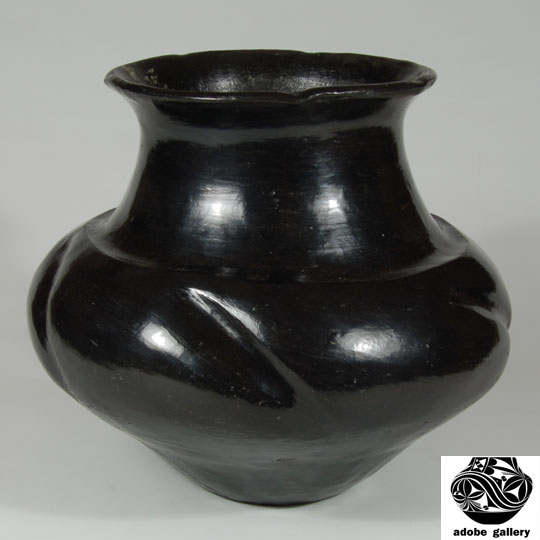 If there ever was a vessel shape that identified itself as Santa Clara Pueblo in origin, this is it. It is one of the most beautiful and graceful shapes of any Tewa wares. It has been attributed to Sara Fina Tafoya with good reason. It exhibits her hand in every respect-shape, quality, fluted neck, and dimpled mid-body. It was constructed of native Tewa clay and coil-formed in the traditional manner.
If there ever was a vessel shape that identified itself as Santa Clara Pueblo in origin, this is it. It is one of the most beautiful and graceful shapes of any Tewa wares. It has been attributed to Sara Fina Tafoya with good reason. It exhibits her hand in every respect-shape, quality, fluted neck, and dimpled mid-body. It was constructed of native Tewa clay and coil-formed in the traditional manner.
Hopi Motsin - Disheveled - Katsina Doll by Roy Tawahongva - C3627E
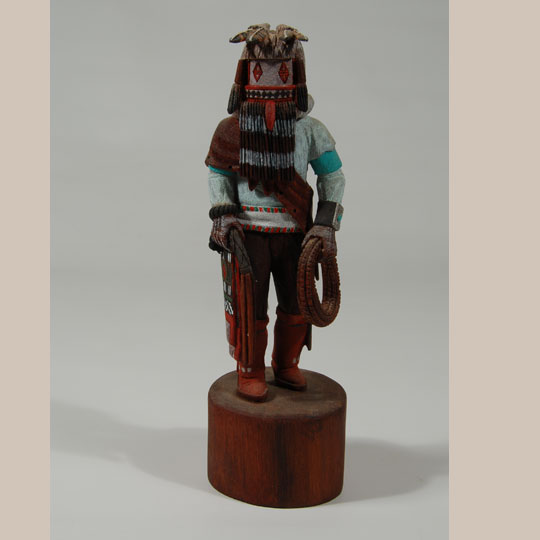 There is very little information published on the artist Roy Tawahongva. From his brother's (Mark Tawahongva) biographical information, who is listed as being born in 1948 at the Hopi village of Hotevilla, one can assume that Roy is 65 or more years old and was from the village of Hotevilla, as well. Roy is listed as being a katsina doll carver and a jeweler.
There is very little information published on the artist Roy Tawahongva. From his brother's (Mark Tawahongva) biographical information, who is listed as being born in 1948 at the Hopi village of Hotevilla, one can assume that Roy is 65 or more years old and was from the village of Hotevilla, as well. Roy is listed as being a katsina doll carver and a jeweler.
Hopi Pueblo Kokosori Katsina Doll with a Rabbit by Lowell Talashoma, Sr. - C3627G
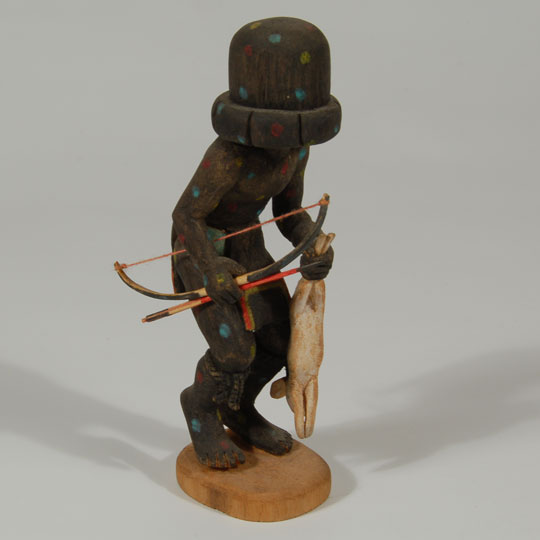 A pre-pubescent boy always portrays Kokosori. Formally his presentation was without clothing. He is one of the oldest recorded katsinas for the Hopi, as he was seen in 1852 according to documented records. He is best known in Zuni Pueblo, where his name is Shulawitsi. At both Zuni and Hopi, he is often referred to as the Fire God Katsina. He appears on all three Hopi mesas in differing functions. As portrayed here, he is shown after a successful rabbit hunt.
A pre-pubescent boy always portrays Kokosori. Formally his presentation was without clothing. He is one of the oldest recorded katsinas for the Hopi, as he was seen in 1852 according to documented records. He is best known in Zuni Pueblo, where his name is Shulawitsi. At both Zuni and Hopi, he is often referred to as the Fire God Katsina. He appears on all three Hopi mesas in differing functions. As portrayed here, he is shown after a successful rabbit hunt.
Mojave Standing Male Pottery Figurine with Beads - C3251B
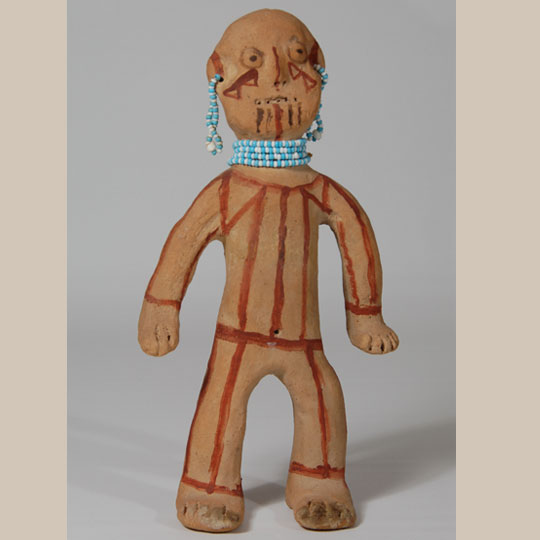 Rick Dillingham, a nationally known artist and a collector and author of Native American pottery, amassed, over many years, a collection of Mojave pottery, and bequeathed it to the School for Advanced Research (SAR) in Santa Fe. His collection was the largest and most complete Mojave assemblage in the world. It has been fully documented in the book Mojave Pottery, Mojave People: The Dillingham Collection of Mojave Ceramics by Jill Leslie Furst and published by the SAR Press in 2001.
Rick Dillingham, a nationally known artist and a collector and author of Native American pottery, amassed, over many years, a collection of Mojave pottery, and bequeathed it to the School for Advanced Research (SAR) in Santa Fe. His collection was the largest and most complete Mojave assemblage in the world. It has been fully documented in the book Mojave Pottery, Mojave People: The Dillingham Collection of Mojave Ceramics by Jill Leslie Furst and published by the SAR Press in 2001.
Oil Painting “Sangre de Cristo Range” by Carl Von Hassler - C3844
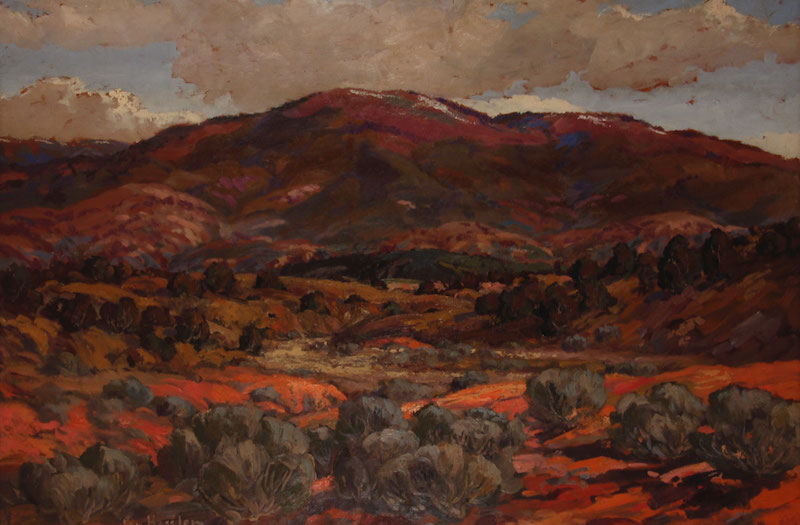 This painting is very representative of Von Hassler's northern New Mexico landscapes, although it is much larger than most of his works. Large paintings express his talents more accurately than the smaller quick ones he painted so he could make a fast sale. Large ones took time and patience and more careful attention. They were apparently ones he enjoyed working on when time permitted.
This painting is very representative of Von Hassler's northern New Mexico landscapes, although it is much larger than most of his works. Large paintings express his talents more accurately than the smaller quick ones he painted so he could make a fast sale. Large ones took time and patience and more careful attention. They were apparently ones he enjoyed working on when time permitted.
This painting is entitled "Sangre de Cristo Range" on verso. It is signed in lower left but not dated. It probably dates from the mid-twentieth century.
Ohkay Owingeh Pueblo Painting “Eagle Dance” by Manuel Trujillo - C3839C
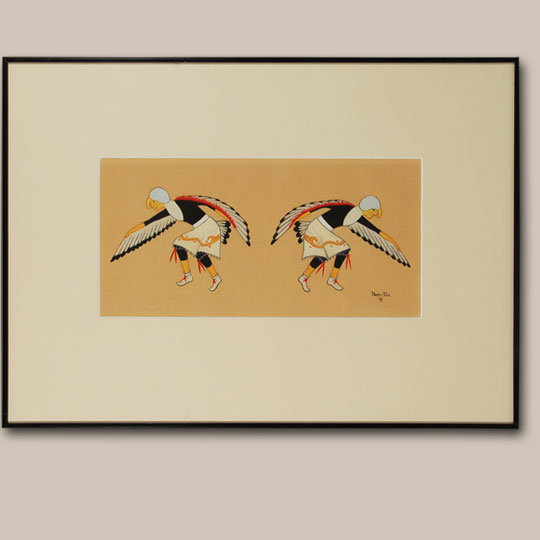 Surprisingly, this is the first painting by Manuel Trujillo (1927 -) Peen Tsa we have had in the gallery. This one was painted while he was a student at the Santa Fe Indian School. It bears the stamp of The Studio U. S. Indian School Santa Fe, NM on the back. It is dated October 6, 1941 on verso and signed and dated 1943 on the lower right front.
Surprisingly, this is the first painting by Manuel Trujillo (1927 -) Peen Tsa we have had in the gallery. This one was painted while he was a student at the Santa Fe Indian School. It bears the stamp of The Studio U. S. Indian School Santa Fe, NM on the back. It is dated October 6, 1941 on verso and signed and dated 1943 on the lower right front.
Hopi Pueblo Pottery Tile of Kokopellmana Katsina by Gwen Setalla - C3843L
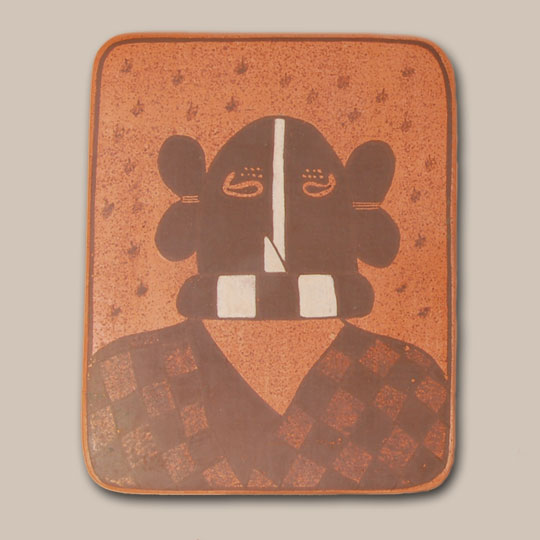 Gwen Sharon Setalla (b.1964-) Aȁs-kữ-Mana is a Hopi from the village of Mishongnovi on Second Mesa. Her mother is Pauline Setalla from Mishongnovi. They are of the Frog Woman and Feather Woman families. The family lived on a ranch not far from Keams Canyon and Gwen spent her early childhood there. She learned pottery making from her mother, starting as early as age 5 and began to take it seriously by age 21.
Gwen Sharon Setalla (b.1964-) Aȁs-kữ-Mana is a Hopi from the village of Mishongnovi on Second Mesa. Her mother is Pauline Setalla from Mishongnovi. They are of the Frog Woman and Feather Woman families. The family lived on a ranch not far from Keams Canyon and Gwen spent her early childhood there. She learned pottery making from her mother, starting as early as age 5 and began to take it seriously by age 21.
Hopi Pottery Tile with Sio Hemis Katsina Face by Barbara Polacca - C3843Q
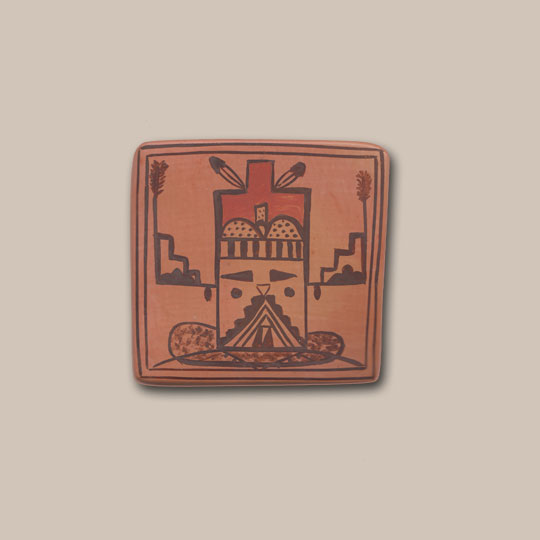 Barbara Polacca is a Hopi-Tewa of the Spider Clan who has been an active potter since 1970. She is an accomplished potter known for making seed jars, cylindrical vases, bowls, canteens and tiles. She painted the face of a katsina on this tile. Pueblo pottery tiles have been a popular collector's item for over a hundred years. The Hopi-Tewa potters have always been more prolific than the Rio Grande Pueblos in making them.
Barbara Polacca is a Hopi-Tewa of the Spider Clan who has been an active potter since 1970. She is an accomplished potter known for making seed jars, cylindrical vases, bowls, canteens and tiles. She painted the face of a katsina on this tile. Pueblo pottery tiles have been a popular collector's item for over a hundred years. The Hopi-Tewa potters have always been more prolific than the Rio Grande Pueblos in making them.
Original Hopi Pueblo Painting of a Buffalo Dancer by Lomawywesa - C3840A
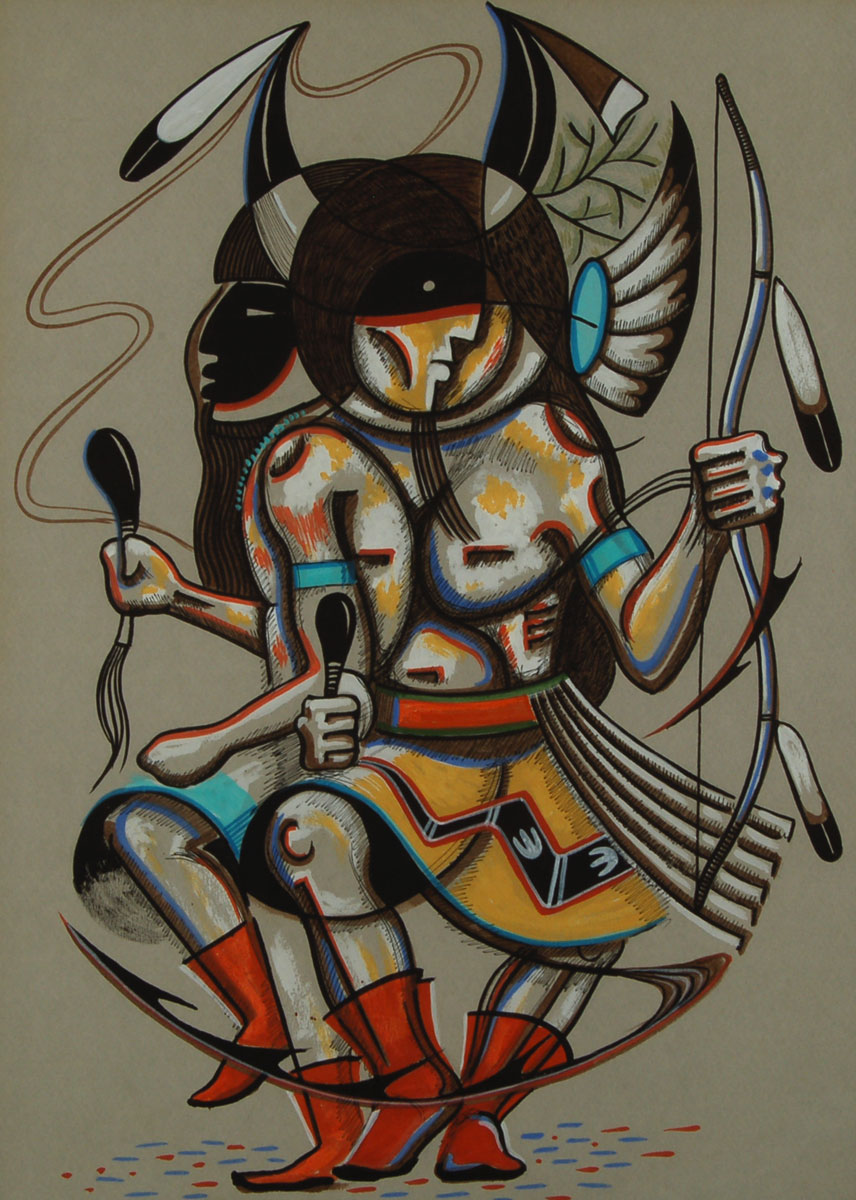 This painting of a Buffalo Dancer was sold through the Hopi Arts and Crafts Shop at Second Mesa on the Hopi Reservation. The Hopi Arts and Crafts Shop was the original outlet for works by the Artist Hopid.
This painting of a Buffalo Dancer was sold through the Hopi Arts and Crafts Shop at Second Mesa on the Hopi Reservation. The Hopi Arts and Crafts Shop was the original outlet for works by the Artist Hopid.
It appears that Kabotie failed to sign this Original Hopi Painting of a Buffalo Dancer, however it does have a Hopi Arts and Crafts tag taped to the back of the painting with the artist listed as Michael Kabotie so there is no doubt that he was the artist. It is also unmistakably the work of Michael Kabotie (1942 - 2009) Lomawywesa.
Original Watercolor Painting “New Mexico Memories” by Morris Rippel - C3843B
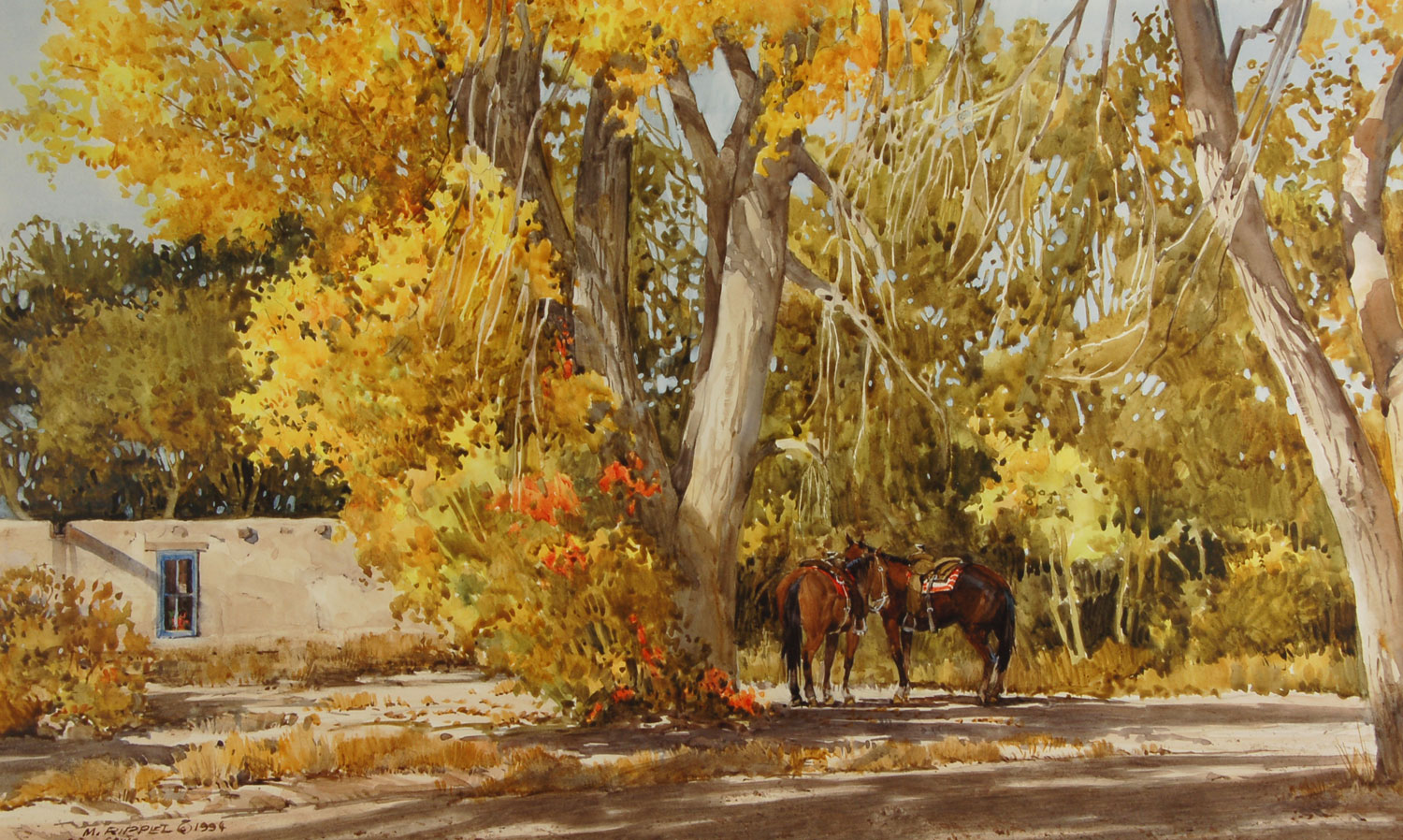 "New Mexico Memories" is an apt name for this painting. There is nothing more New Mexican that an adobe building nestled under or among cottonwood trees. There is no manicured lawn or formal entrances to the home, just native plants growing without need of water or attention. The two saddled horses are ready for a tromp down by the acequia. The cottonwood trees are displaying their beautiful fall colors. There is no memory of New Mexico more memorable that such a view as this.
"New Mexico Memories" is an apt name for this painting. There is nothing more New Mexican that an adobe building nestled under or among cottonwood trees. There is no manicured lawn or formal entrances to the home, just native plants growing without need of water or attention. The two saddled horses are ready for a tromp down by the acequia. The cottonwood trees are displaying their beautiful fall colors. There is no memory of New Mexico more memorable that such a view as this.
Morris Rippel was basically a self-trained artist, having obtained an architectural degree from the University of New Mexico. He worked in that field for 15 years but then decided to see if he could make a living for himself and his family by becoming an easel artist. He succeeded and did so very well.
Original Watercolor Painting “Romero Street” by Morris Rippel - C3843A
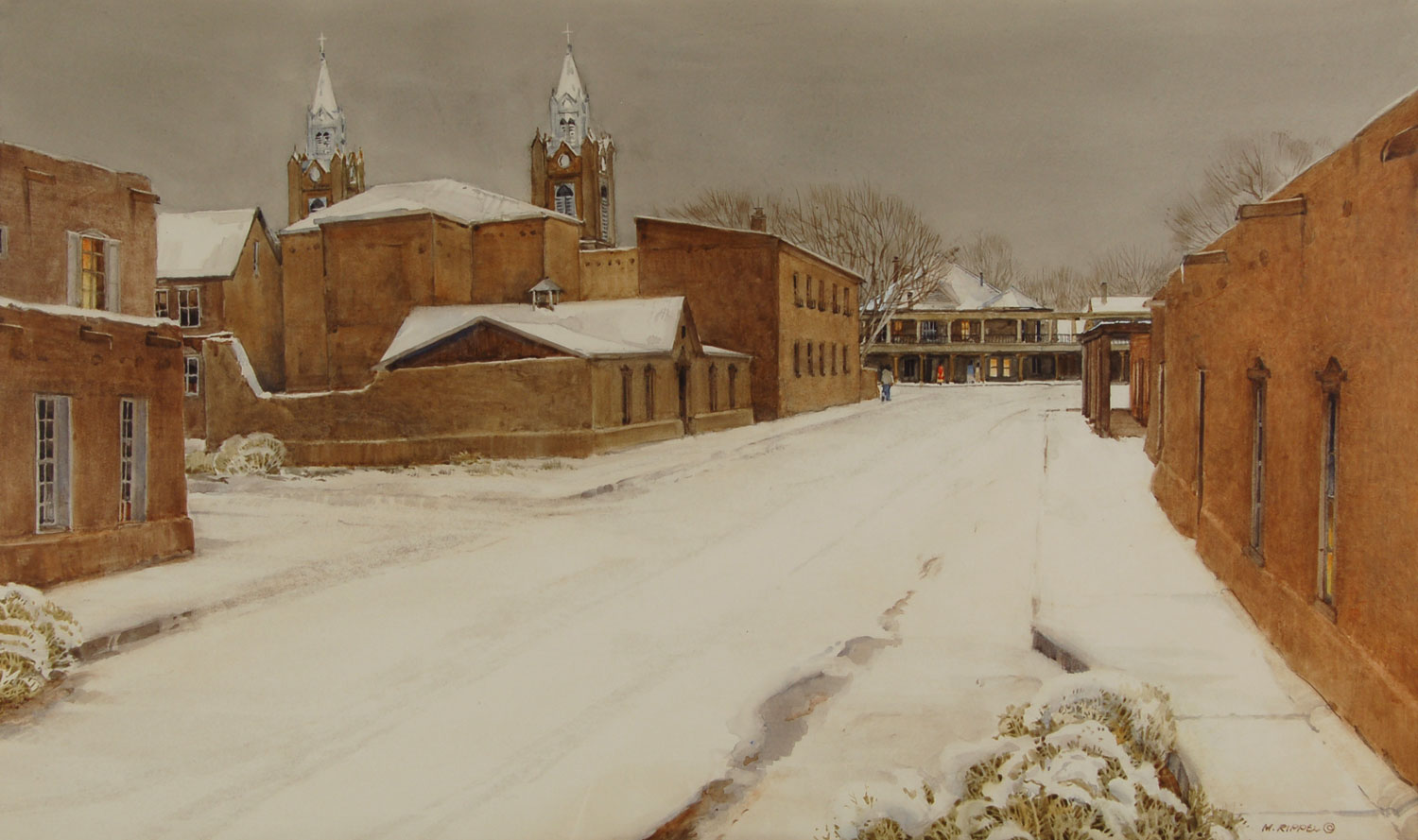 Morris Rippel lived his whole life in Albuquerque. He attended the University of New Mexico from which he earned a degree in architecture, a career he practiced for 15 years. He decided to try his hand at fine art painting and took two paintings to a gallery in Santa Fe which sold them immediately so he decided to drop his architectural career and become a fine art painter. He had a very successful art career.
Morris Rippel lived his whole life in Albuquerque. He attended the University of New Mexico from which he earned a degree in architecture, a career he practiced for 15 years. He decided to try his hand at fine art painting and took two paintings to a gallery in Santa Fe which sold them immediately so he decided to drop his architectural career and become a fine art painter. He had a very successful art career.
This watercolor of Romero Street is a very accurate portrayal of that section of Old Town Albuquerque. The long adobe building on the right with two long and narrow windows and a door was the home of Adobe Gallery for 25 years! We have fond memories of that building.
Hopi Pueblo Kwivi Koyemsi Katsina Doll - C3843C
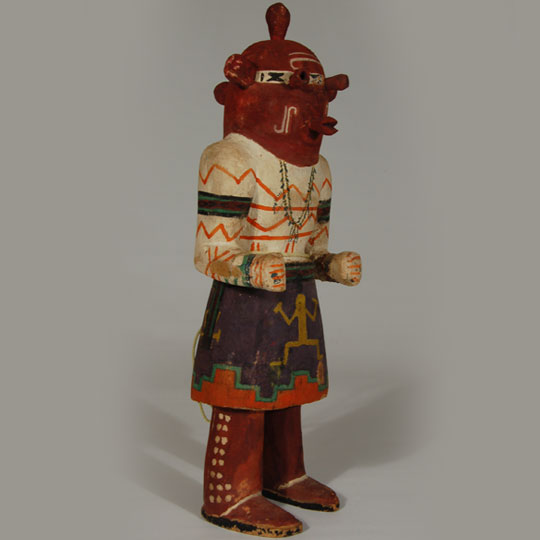 This personage has been known by several names-Mudhead, Koyemsi, Clown, Tachukti, and has been referred to as a Katsina. Barton Wright states that it is not considered a Katsina at Hopi and that Mudhead and Koyemsi are both nicknames and that Tachukti is the correct name but that he is not a clown in the sense we normally consider a clown. It will, however, always be called a Mudhead as that name has existed for a hundred years already and is not likely to go away.
This personage has been known by several names-Mudhead, Koyemsi, Clown, Tachukti, and has been referred to as a Katsina. Barton Wright states that it is not considered a Katsina at Hopi and that Mudhead and Koyemsi are both nicknames and that Tachukti is the correct name but that he is not a clown in the sense we normally consider a clown. It will, however, always be called a Mudhead as that name has existed for a hundred years already and is not likely to go away.
Artist Profile - Myron Denetclaw (1999- )
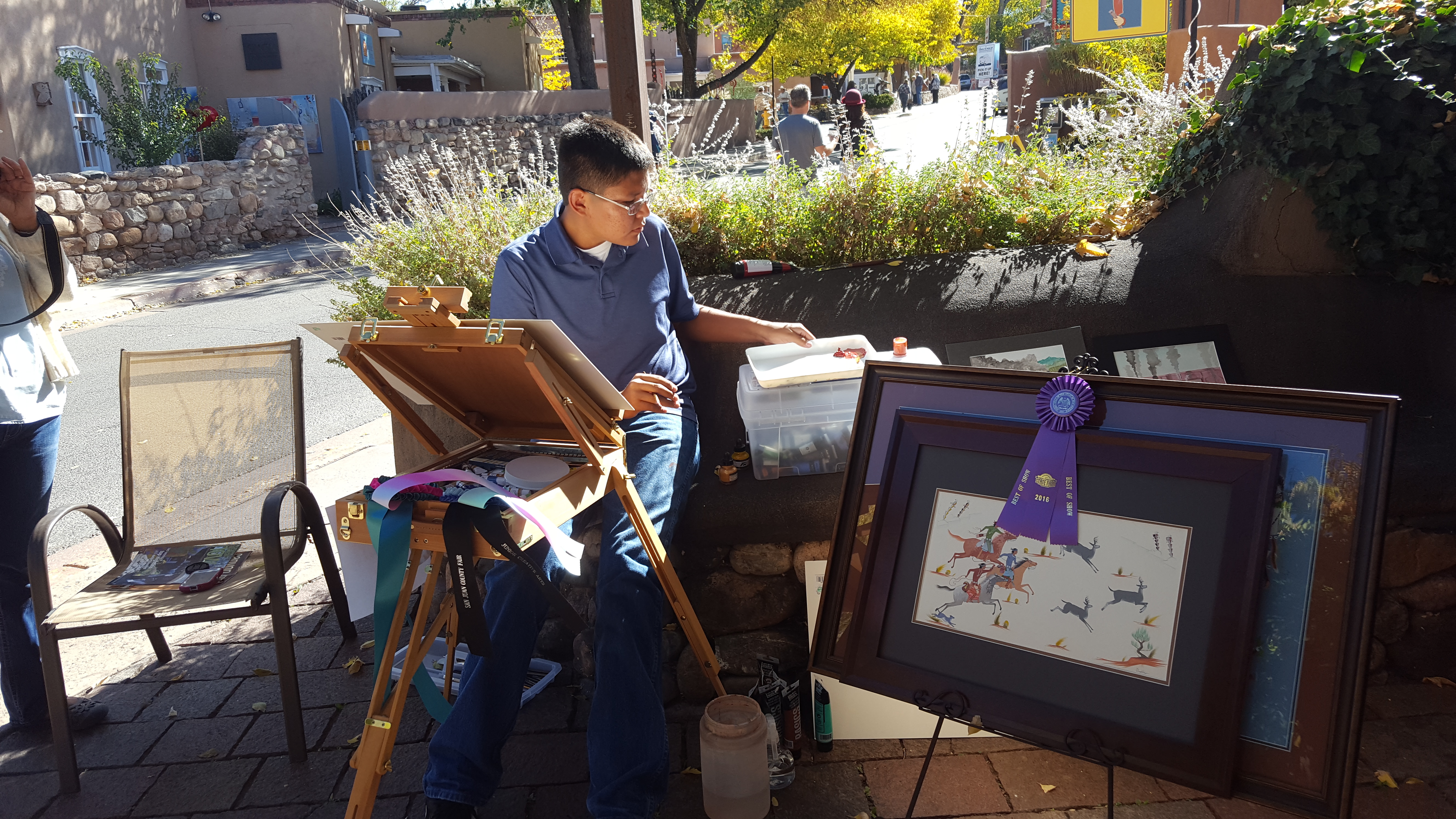 Myron Denetclaw is a self-taught painter born on September 5, 1999 in Shiprock, New Mexico. He resides in Shiprock with his parents, Milford and Mamie Denetclaw and brother Matthew. His maternal clan is Táchiiníí and his paternal clan is Hooghanłání.
Myron Denetclaw is a self-taught painter born on September 5, 1999 in Shiprock, New Mexico. He resides in Shiprock with his parents, Milford and Mamie Denetclaw and brother Matthew. His maternal clan is Táchiiníí and his paternal clan is Hooghanłání.
Denetclaw developed his painting ability slowly through trial and error by practice of drawing. He holds in particular esteem the naturalism of Bob Ross' work which is a significant force characterized by an ongoing determination to produce beautifully rendered gouache and acrylic paintings with a specific emphasis on Yeíí, the Diné Deities. Denetclaw's interest in the elegance of the spiritual world finds expression within his figurative subjects, the intimacy of which invites us to reflect freely upon their narrative content. He paints in the style of the early Navajo painters Harrison Begay and Beatien Yazz. There are not many young Navajo artists today who paint in this style. His work is clearly influenced by his predecessors, while expanding on their style in a way that only a young artist would. We are very impressed by this emerging artist's work, and are excited to be able to share it with our clients.
Learn more about Myron Denetclaw here.
Untitled Painting of Navajo Boys Chasing Deer by Myron Denetclaw - 25907
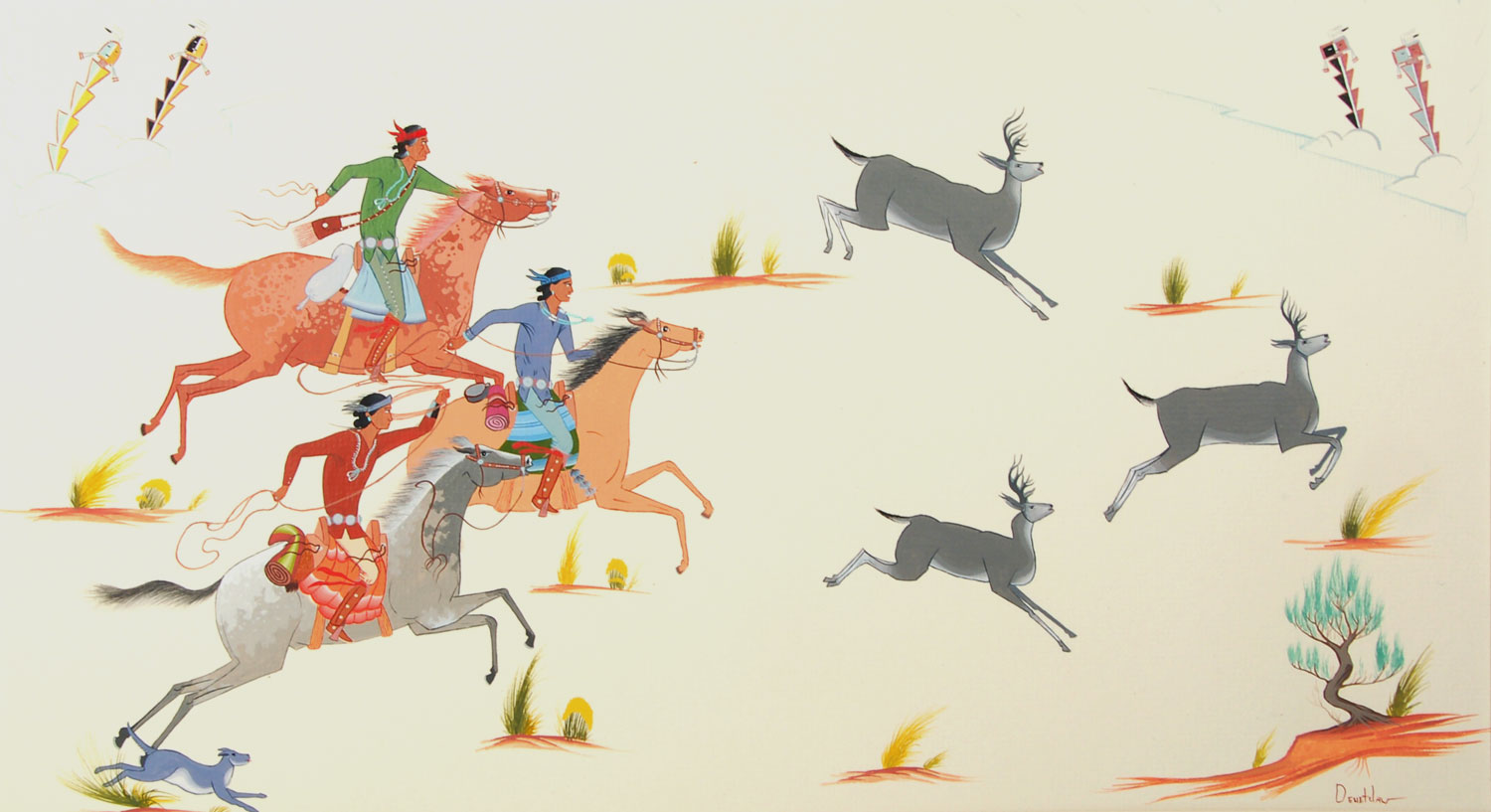 Self-taught artist Myron Denetclaw paints in the style of the early Navajo painters Harrison Begay and Beatien Yazz. Myron developed his painting ability slowly through trial and error by practice of drawing. He holds in particular esteem the naturalism of Bob Ross' work which is a significant force characterized by an ongoing determination to produce beautifully rendered gouache and acrylic paintings with a specific emphasis on Yeíí, the Diné Deities. Denetclaw's interest in the elegance of the spiritual world finds expression within his figurative subjects, the intimacy of which invites us to reflect freely upon their narrative content.
Self-taught artist Myron Denetclaw paints in the style of the early Navajo painters Harrison Begay and Beatien Yazz. Myron developed his painting ability slowly through trial and error by practice of drawing. He holds in particular esteem the naturalism of Bob Ross' work which is a significant force characterized by an ongoing determination to produce beautifully rendered gouache and acrylic paintings with a specific emphasis on Yeíí, the Diné Deities. Denetclaw's interest in the elegance of the spiritual world finds expression within his figurative subjects, the intimacy of which invites us to reflect freely upon their narrative content.
Hopi Cottonwood Kokopelli Katsina Doll with Genitalia by Jimmie Koots - C3843i
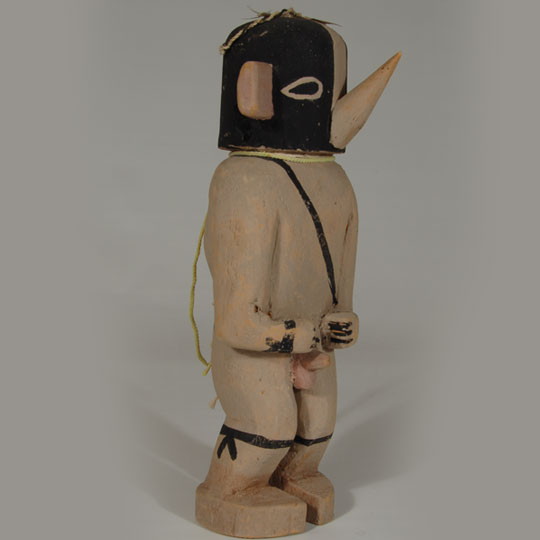 Jimmie Kootshongsie is best known by everyone as Jimmie Koots. He was born at Hopi Pueblo on the Third Mesa village of Hotevilla during the period of World War I. At a very young age, he and many other Hopi children were removed from their homes and taken to government schools where they were to be stripped of their Hopi beliefs and heritage and assimilated into the White man's culture. Koots survived the five long years at the Bureau of Indian Affairs School and then returned to his native village.
Jimmie Kootshongsie is best known by everyone as Jimmie Koots. He was born at Hopi Pueblo on the Third Mesa village of Hotevilla during the period of World War I. At a very young age, he and many other Hopi children were removed from their homes and taken to government schools where they were to be stripped of their Hopi beliefs and heritage and assimilated into the White man's culture. Koots survived the five long years at the Bureau of Indian Affairs School and then returned to his native village.

